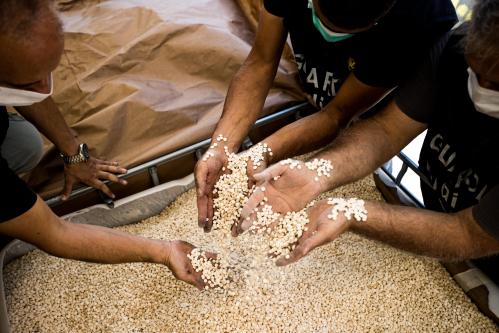First in a series of daily analyses by Brookings scholars of new developments in the Iraq war.
The first day of the war against Iraq has been full of surprises. The attempted decapitation of Saddam’s regime by cruise missiles and F-117 fighters, prior to any attacks against the dense air defenses around Baghdad, was not what had been advertised by those who anticipated a massive “shock and awe” salvo to mark the war’s opening. And Iraq’s use of conventionally-armed warheads on ballistic missiles against U.S. troops in Kuwait has been no more than a nuisance, at least up until this hour. These are probably the two most significant events of the war’s opening 18 hours.
Consider first the missile issue. It is hardly surprising that Saddam possesses or would use his ballistic missiles. It may be somewhat surprising that he has apparently chosen to use them against American forces in the field—a relatively dispersed and relatively well protected target. Less surprising, since Saddam has not been able to test his missile force very much since 1991, its capacity for delivering chemical or biological agents probably remains mediocre, which may explain why he has reportedly used conventional explosives rather than weapons of mass destruction atop the missiles. Ballistic missiles need special submunitions to deliver chemical or biological agent effectively, and those submunitions need good fuses to release the agent at the proper altitude for covering a broad region. Finally, it is possible that the improved version of the Patriot missile defense system—actually, in most ways a whole new system—has intercepted some of the incoming missiles.
But the big question is the attempted decapitation. In principle it was a sound idea. It was probably made possible by a new kind of intelligence—CIA operatives on the ground, for example, or unmanned aerial vehicles overflying Baghdad and taking continuous high-resolution video photos—because it seems doubtful that Saddam would use satellite phones or otherwise leave himself vulnerable to traditional intelligence tools. The big issue, however, is why did it take almost six hours from the time we learned of Saddam’s whereabouts to the moment when bombs struck targets? This type of opportunity should have been foreseen and foreseeable, with procedures already in place to expedite rapid decisionmaking on whether to attack. (The main issue would be whether our chance of getting Saddam was great enough to warrant revealing something about our new intelligence sources and methods?) The F-117s could have been sortied almost as soon as CIA Director George Tenet had the intelligence; President Bush, having thought about this type of scenario in advance, could have then quickly made a decision to let them strike the targets. By then, aircraft would have been approaching Baghdad. It might have been necessary to use more planes—four, eight, even a dozen—since cruise missiles would not be appropriate for this mission (given their longer time to target and inability to be recalled). But we certainly have enough airplanes in Kuwait to generate that type of force. The entire procedure might have taken 1 or 1 ½ hours under those circumstances, probably with a much greater chance of success. Bombs would have begun to fall before the formal expiration of the 48-hour deadline President Bush gave Saddam on Monday night, but as we were all told all week, that deadline was crafted in such a way as to become irrelevant once Saddam refused it—as he already had.
This debate could ultimately be as big as the debate over how we let Osama bin Laden get away at Tora Bora in December 2001. I hope it will not be. Indeed, it is surely possible that some of the initial public information about what happened yesterday is wrong, in which case the above critique may be unfounded. But if the war drags on and we do not get a second chance to strike at Saddam, this in retrospect will have been a bad first day.



Commentary
Op-edThe War’s First Day: Did We Blow Our Best Chance To Get Saddam?
March 20, 2003